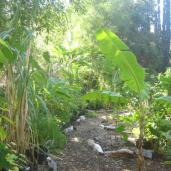I recently traveled across the southern US and had some interesting experiences from a sustainability viewpoint. Near Santa Fe, I stayed at the Permaculture Institute.
They have a community there, and offered me a stay in a beautiful adobe home for a very small fee. The founder of the Institute is Scott Pittman, well known permaculturist. His house, built of straw bale, had a couple of interesting elements to it. There was an indoor jungle/wetlands system that handled all the greywater and blackwater from the house (for those not familiar, greywater is all the used water from sinks, showers, washer and dryer, but not the toilets, which is blackwater). Big banana trees, a small pond with fish, a cherimoya fruit tree, lots of lushness. There were exotic birds flying through the trees, chirping. What a nice thing to have in the middle of the house! In winter it must be really pleasant to have that green there, at 7000 feet or so, it can get quite cold.
The terrarium gets light and heat from a panel of skylights which is diffused and limited in size so it doesn’t get too hot. They found out afterwards it did not provide enough light for the vegetation to produce much food, but it still provides lots of clean air and aesthetics. The skylights are angled so that in the summer the light hits the plants which absorb the heat, and in the winter, the light hits a thick adobe wall that absorbs the heat and radiates it to the back of the house, which has no heater and per the residents, never needs one. They also have a big masonry stove that takes a chunk of wood to get started, but if the fire is kept going in the winter, even at very low volume, it hardly needs any fuel to keep going. Per Scott’s wife, most residents in the area go through one to three cords of wood per year, but they take three years to go through one cord. The passive heating and cooling systems were well thought out throughout the house- using air flows, lighting, thermal mass, ceiling size, etc, to create heat where it was needed and prevent too much where it was not. It’s a large house with high ceilings, which would normally take more energy to heat and cool than the average home, but uses far less energy than most homes. Radiant heat from thermal mass is a superior heat by test, warming bodies more effectively and pleasantly than forced air heat, and without drying the air or stirring up dust.
Permacultureinstitute.org
Anna Edey (solviva.com) has been successfully growing copious amounts of food inside her home for decades, and her greenhouse design is one of the best out there. She uses a different type of thermal mass – the living bodies of chickens help heat her home via an attached chicken coop which transmits their radiant body heat into the house via the common wall they share.
Adding a rain catchment system to the house could provide water for non-potable use (or even potable with a good filter) – see oasisdesign.net. Choosing food, such as sprouts and other items that grow in small spaces, could increase the amount of nutrition that is provided. A combination of these techniques and the ones used at the Permaculture Institute, could create a structure that would provide much of the resident’s food, energy and water needs within the structure itself!
When trying to create systems that produce more than they use in resources, that live lightly on the earth and perhaps even contribute to her bounty, these techniques become key.
Designing a life with these elements does not involve austerity, but abundance - it is far from punishment!
Anna’s home designs are aesthetic, pleasurable masterpieces, full of light and life – imagine reaching for a delicious, organic, heirloom tomato while you are bathing with sunlight streaming through greenhouse glass above you, or as you are sitting at your kitchen table. Imagine watching birds flit from branch to branch in the nearby atrium as you relax in your living room. Imagine walking a few steps to pick a ripe banana in the middle of winter, surrounded by lush greenery. Imagine the coziness of curling up in bed in the middle of winter in a room heated with radiant heat, emanating from the walls and floor.
Imagine having an energy and water bill that are so low as to be almost nonexistent. And imagine experiencing the feeling that you are helping the planet by living like this.
Living “green” truly offers the potential of a higher quality of life, from every angle. Which only makes sense, doesn’t it? What is good for the earth and its living creatures should also be good for mankind, who is, after all, a part of the larger dynamic of all life forms.
Wednesday, September 17, 2008
Aesthetic solutions
Subscribe to:
Post Comments (Atom)




No comments:
Post a Comment